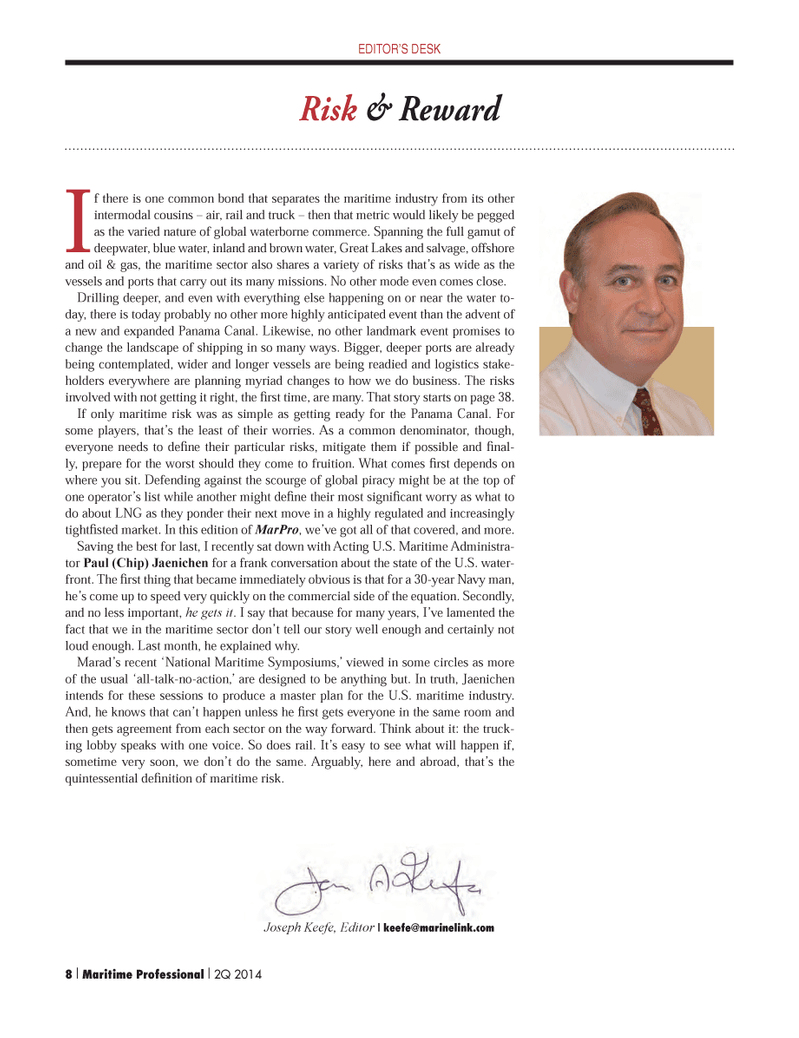
Page 8: of Maritime Logistics Professional Magazine (Q2 2014)
Maritime Risk & Shipping Finance
Read this page in Pdf, Flash or Html5 edition of Q2 2014 Maritime Logistics Professional Magazine
Risk & Reward
EDITOR’S DESK
I f there is one common bond that separates the maritime industry from its other intermodal cousins – air, rail and truck – then that metric would likely be pegged as the varied nature of global waterborne commerce. Spanning the full gamut of deepwater, blue water, inland and brown water, Great Lakes and salvage, offshore and oil & gas, the maritime sector also shares a variety of risks that’s as wide as the vessels and ports that carry out its many missions. No other mode even comes close.
Drilling deeper, and even with everything else happening on or near the water to- day, there is today probably no other more highly anticipated event than the advent of a new and expanded Panama Canal. Likewise, no other landmark event promises to change the landscape of shipping in so many ways. Bigger, deeper ports are already being contemplated, wider and longer vessels are being readied and logistics stake- holders everywhere are planning myriad changes to how we do business. The risks involved with not getting it right, the fi rst time, are many. That story starts on page 38.
If only maritime risk was as simple as getting ready for the Panama Canal. For some players, that’s the least of their worries. As a common denominator, though, everyone needs to defi ne their particular risks, mitigate them if possible and fi nal- ly, prepare for the worst should they come to fruition. What comes fi rst depends on where you sit. Defending against the scourge of global piracy might be at the top of one operator’s list while another might defi ne their most signifi cant worry as what to do about LNG as they ponder their next move in a highly regulated and increasingly tightfi sted market. In this edition of MarPro, we’ve got all of that covered, and more.
Saving the best for last, I recently sat down with Acting U.S. Maritime Administra- tor Paul (Chip) Jaenichen for a frank conversation about the state of the U.S. water- front. The fi rst thing that became immediately obvious is that for a 30-year Navy man, he’s come up to speed very quickly on the commercial side of the equation. Secondly, and no less important, he gets it. I say that because for many years, I’ve lamented the fact that we in the maritime sector don’t tell our story well enough and certainly not loud enough. Last month, he explained why.
Marad’s recent ‘National Maritime Symposiums,’ viewed in some circles as more of the usual ‘all-talk-no-action,’ are designed to be anything but. In truth, Jaenichen intends for these sessions to produce a master plan for the U.S. maritime industry.
And, he knows that can’t happen unless he fi rst gets everyone in the same room and then gets agreement from each sector on the way forward. Think about it: the truck- ing lobby speaks with one voice. So does rail. It’s easy to see what will happen if, sometime very soon, we don’t do the same. Arguably, here and abroad, that’s the quintessential defi nition of maritime risk.
Joseph Keefe, Editor | [email protected] 8 I Maritime Professional I 2Q 2014 1-17 Q2 MP2014.indd 8 5/16/2014 11:40:45 AM

 7
7

 9
9
